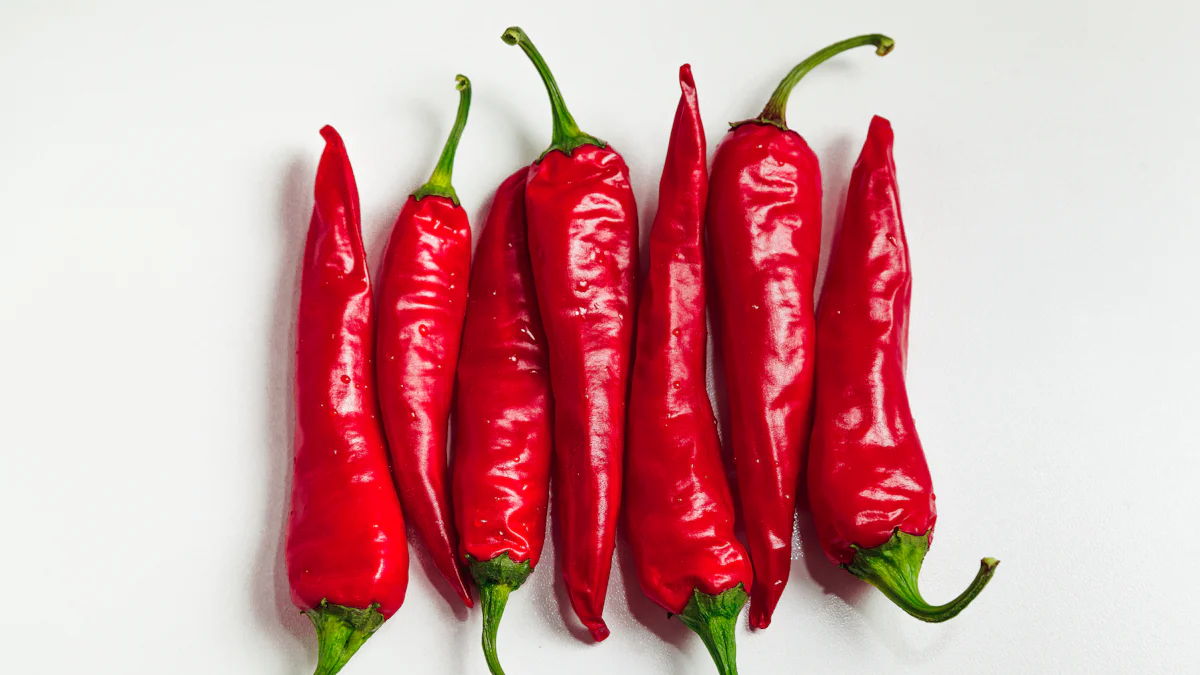Paprika vs Cayenne Pepper: Unveiling the Differences

Unveiling the Differences
When it comes to adding a burst of flavor to our dishes, paprika and cayenne pepper are two popular spices that immediately come to mind. These seasonings not only enhance the taste of our culinary creations but also bring a unique touch to our meals. In this section, we will delve into the distinct flavor profiles of paprika and cayenne pepper, explore their origins and unique characteristics, and understand the differences and similarities between these versatile spices.
Paprika is a vibrant red spice that originates from dried peppers. It is known for its rich, sweet, and slightly smoky flavor profile. The taste of paprika can range from mild to hot, depending on the variety used. This spice adds depth and color to dishes, making it a favorite in Hungarian cuisine where it is often used in goulash and other traditional recipes.
On the other hand, cayenne pepper is derived from dried and ground chili peppers. It offers a fiery heat with a distinctively pungent flavor. Cayenne pepper is commonly associated with spiciness due to its high capsaicin content. Its intense heat can add an exciting kick to various dishes like spicy curries or hot sauces.
While both paprika and cayenne pepper are seasonings that serve as flavor enhancers, they differ significantly in terms of taste intensity and heat levels. Paprika tends to have a milder flavor compared to cayenne pepper, which packs more heat. The choice between these spices depends on personal preference and the desired level of spiciness in your dish.
By understanding the differences between paprika and cayenne pepper, you can make informed decisions about which spice to use based on your recipe's requirements. Whether you're looking for a subtle sweetness or an intense fiery kick, these versatile spices offer an array of flavors that can elevate your culinary creations.

Origins and Background
Paprika, also known as sweet pepper powder or pimentón, has a fascinating history and cultural significance. This spice originated from the dried and ground fruits of Capsicum annuum, a type of sweet pepper. The origins of paprika can be traced back to Central America, where it was first cultivated by the indigenous people thousands of years ago.
Over time, paprika made its way to Europe through explorers and traders. It gained popularity in Hungary, where it became an integral part of Hungarian cuisine. Today, Hungary is renowned for producing some of the highest quality paprika in the world. The country's favorable climate and fertile soil create optimal conditions for growing flavorful peppers used in paprika production.
Cayenne pepper, on the other hand, has a different historical usage and origin story. It is derived from red chili powder made from various hot chili peppers. Cayenne pepper gets its name from the city of Cayenne in French Guiana, which served as a major trading port for spices during colonial times.
While cayenne pepper is associated with its namesake city, it is commonly grown in many countries around the world today. Some of the leading producers include India, Mexico, China, Nigeria, and Thailand. These regions have ideal climates for cultivating hot chili peppers that are then dried and ground into cayenne pepper.
Both paprika and cayenne pepper have unique origins that contribute to their distinct flavors and characteristics. Understanding their backgrounds allows us to appreciate their cultural significance while incorporating them into our culinary creations.
Flavor Profiles and Characteristics
When it comes to flavor profiles, paprika and cayenne pepper offer distinct tastes and characteristics that can elevate your culinary creations. Let's explore their unique qualities in more detail.
Paprika Flavor Profile
Paprika is known for its rich taste and vibrant red color. It adds a mild sweetness with subtle hints of smokiness to dishes. The aroma of paprika is earthy and slightly peppery, enhancing the overall sensory experience. The flavor intensity of paprika can vary depending on the variety used. Some varieties offer a mild and sweet profile, while others have a more robust and pungent taste.
There are several types of paprika available, each with its own flavor intensities. Hungarian sweet paprika is one of the most popular varieties, offering a balanced sweetness with a mild heat level. Spanish smoked paprika, also known as pimentón, has a distinct smoky flavor that adds depth to dishes like paella or chorizo.
Cayenne Pepper Flavor Profile
Cayenne pepper is renowned for its fiery heat and bold flavor. It provides a spicy kick to dishes along with complex flavor nuances. The taste of cayenne pepper is characterized by its intense heat, but it also offers subtle earthy and fruity notes. The aroma of cayenne pepper is pungent and distinctive.
Different types of cayenne pepper exist, each varying in heat levels and flavors. The standard cayenne pepper powder available in most stores has a moderate to high level of spiciness. However, there are milder versions available for those who prefer less heat in their dishes. Additionally, some specialty cayenne peppers may have unique flavors such as citrusy or smoky undertones.
Both paprika and cayenne pepper bring their own distinct flavors to the table, making them versatile spices in various culinary applications. Understanding their flavor profiles allows you to choose the right spice for your recipes based on the desired taste experience.
Culinary Uses and Applications
When it comes to culinary uses, both paprika and cayenne pepper offer unique flavors that can enhance a wide range of dishes. Let's explore how these spices are used in cooking and the various applications they bring to the table.
Paprika in Cooking
Paprika is a staple ingredient in many traditional dishes and cuisines. It is commonly found in Hungarian, Spanish, and Indian recipes, among others. In Hungarian cuisine, paprika plays a central role in iconic dishes like goulash, where it adds depth and color to the rich stew. Spanish cuisine utilizes smoked paprika (pimentón) in dishes such as paella or chorizo for its distinct smoky flavor.
In addition to its traditional uses, paprika has also found its way into modern recipes, offering creative twists to familiar dishes. It can be sprinkled over roasted vegetables for added flavor and visual appeal or used as a seasoning for grilled meats. Paprika-infused oils or butters can be drizzled over pasta or bread for an extra burst of taste.

Cayenne Pepper in Cooking
Cayenne pepper is widely used in various cuisines around the world, particularly those that embrace spicy flavors. It is a key ingredient in Mexican cuisine, adding heat to salsas, enchiladas, and chili con carne. In Cajun and Creole cooking from Louisiana, cayenne pepper is essential for creating flavorful jambalaya or gumbo.
To incorporate cayenne pepper into your recipes, start by adding small amounts according to your desired level of spiciness. It can be used to season marinades for grilled chicken or shrimp skewers or sprinkled over popcorn for a spicy snack. A pinch of cayenne pepper can even elevate chocolate desserts by adding a subtle kick that contrasts with the sweetness.
Both paprika and cayenne pepper offer their own unique culinary applications and flavors. While paprika brings warmth and depth to dishes with its sweet profile, cayenne pepper adds fiery heat that can be adjusted based on personal preference.
Differences and Similarities
When comparing paprika and cayenne pepper, it's important to understand both their distinctive differences and shared similarities. Let's explore the flavor comparison between these two spices and discover how they can complement different types of dishes.
Paprika vs Cayenne Pepper: Flavor Comparison
Paprika and cayenne pepper offer distinct taste differences that set them apart. Paprika brings a mild sweetness with subtle smoky undertones, while cayenne pepper delivers a fiery heat with bold flavor nuances. The choice between these spices depends on the desired level of spiciness in your dish. If you're looking for a milder, sweeter profile, paprika is the way to go. On the other hand, if you crave intense heat and a bolder flavor experience, cayenne pepper is your best bet.
Despite their differences, both paprika and cayenne pepper share commonalities in terms of their culinary applications. They can be used interchangeably in certain recipes where a touch of spiciness is desired. For example, if you're making a spicy rub for grilled meats or adding heat to a tomato-based sauce, either spice can be used based on personal preference or availability in your pantry.
Additionally, both spices offer versatility in various cuisines around the world. They are widely used in dishes from Hungarian goulash to Mexican salsas and Indian curries. Their flavors can enhance everything from soups and stews to marinades and dips.
While there are differences between paprika and cayenne pepper in terms of taste intensity, they also have overlapping uses that allow for creative exploration in the kitchen. Understanding their unique characteristics provides an opportunity to experiment with different flavors and find the perfect balance for your culinary creations.
Nutritional Value of Paprika and Cayenne Pepper
Both cayenne and paprika aren't just flavorful additions to your meals; they pack a nutritional punch too. Let's break down their benefits:
Paprika: This vibrant spice is not only a feast for the taste buds but also a treasure trove of essential nutrients. In addition to its appealing flavor, paprika contributes to your overall well-being through its nutritional content. Here's a more detailed breakdown:
Calcium (15.66 mg): Calcium is a crucial mineral for maintaining strong bones and teeth. It also plays a role in nerve function, blood clotting, and muscle contractions.
Iron (1.44 mg): Iron is vital for the formation of hemoglobin, the substance in red blood cells that transports oxygen throughout the body. Ensuring an adequate iron intake helps prevent fatigue and promotes overall energy levels.
Magnesium (12.1 mg): Magnesium is involved in various physiological functions, including muscle and nerve function, blood glucose control, and bone health.
Potassium (155 mg): This electrolyte is essential for maintaining proper fluid balance, supporting heart health, and assisting in muscle contractions.
Apart from these essential minerals, paprika boasts moderate amounts of vitamins A, E, and B6. These vitamins play key roles in immune function, vision, and the metabolism of proteins, fats, and carbohydrates.
Moreover, paprika's antioxidant content contributes to its potential health benefits. Antioxidants help neutralize free radicals in the body, which can contribute to improved vision and eye health. Additionally, the presence of antioxidants in paprika may aid in controlling blood sugar levels and promoting overall blood health.
Incorporating paprika into your meals not only adds a burst of flavor but also introduces a variety of nutrients that can contribute to your overall health and well-being. And, if opting for organic paprika, you may enhance the quality and purity of these nutritional benefits.
Cayenne: For those who can handle the spice, cayenne powder adds more than just heat to your snacks and meals. It delivers a noteworthy dose of various vitamins, including A, B6, C, and K. Beyond its vitamin content, cayenne may also offer additional health benefits:
Promoting Healthy Digestion: Cayenne has shown evidence of supporting digestive health, ensuring your gut functions smoothly.
Aiding in Weight Management: Some studies suggest that cayenne may play a role in weight management, making it a potentially valuable addition for those on a wellness journey.
Reducing Inflammation: Cayenne may possess anti-inflammatory properties, contributing to overall well-being by addressing inflammation.
So, whether you're sprinkling paprika for its vision-boosting antioxidants or adding cayenne to your meals for digestive support and potential weight management benefits, these spices aren't just flavor enhancers – they're nutritional powerhouses. And if you're contemplating whether to go for organic spices, it might just be a smart move for the highest quality and maximum health benefits.
Insights into Versatile Spices
Paprika and cayenne pepper are truly versatile spices that can elevate your culinary creations to new heights. By understanding their differences and unique characteristics, you can make more precise spice selections and create dishes that tantalize the taste buds.
The comparison between paprika and cayenne pepper reveals a range of flavors, from the mild sweetness of paprika to the fiery heat of cayenne pepper. Each spice brings its own distinct profile to dishes, allowing you to add depth and complexity to your cooking. Whether you're looking for a subtle hint of smokiness or a bold kick of spiciness, these spices have got you covered.
Experimenting with both paprika and cayenne pepper opens up a world of possibilities in the kitchen. You can explore different cuisines and recipes, discovering new taste sensations along the way. From traditional Hungarian goulash to Mexican salsas or Indian curries, these spices find their place in various culinary traditions.
As flavor enhancers, paprika and cayenne pepper offer endless opportunities for creativity. They can be used in marinades, rubs, sauces, soups, stews, or even sprinkled over roasted vegetables for added flair. The key is to find the right balance that suits your personal preferences and desired level of spiciness.
In conclusion, paprika and cayenne pepper are more than just seasonings; they are flavor powerhouses that bring depth and excitement to your dishes. Embrace their unique qualities, experiment with different recipes, and let these versatile spices take your culinary creations to new heights.



